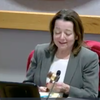GCSD super proposes 84M budget
GUILDERLAND With most New Yorkers in favor of capping school taxes, the superintendent here has presented an $84 million budget proposal for next year, with an estimated tax-rate increase of 1.54 percent for Guilderland residents the smallest hike in at least 15 years.
This represents an increase of 2.2 percent, or $1.8 million, over the current years spending plan.
"The budget is the way we support the mission of our schools and educate our children," said Superintendent John McGuire, referring to the district’s slogan to empower its students to succeed in the 21st Century. "The budget is the underpinning," said McGuire.
He became superintendent last fall and was presenting his first Guilderland budget last Thursday. "I look at it as the balancing of an equation," said McGuire, an experienced administrator.
McGuire attributed the "favorable budget" to several factors "multi-year efforts" and "a very rigorous internal process," in which "a conservative approach" is taken for recommendations on added programs or staff.
Finally, McGuire said, "Never underestimate the power of some luck." He noted that mandated school costs for retirement systems for both teachers and other workers are down, and that revenues for Guilderland’s state aid are projected to be stable.
The budget is being reviewed by 25 volunteers on a citizens advisory committee, which will meet a half-dozen times over the next month in televised sessions. The public will have its say on May 20. Most of the volunteers on the review committee are the parents of children in Guilderland schools.
"I hope we can provide you with information that earns your trust and confidence," McGuire told the committee members. He called the process "a commendable exercise in democracy."
Mark Grimm, a Guilderland Town Board member who is serving on the budget committee, said that, when he was campaigning last fall, he visited 9,000 homes and found "the number-one issue" was high school taxes. He recommended paring away the least effective programs, stating, "School taxes are just too high."
At the end of the session, Grimm asked, with the anticipated drop of 109 students, how many teachers would be cut.
Assistant Superintendent for business Neil Sanders said this week that a total of 8.15 teaching positions would be cut.
Expenditures
Current enrollment at Guilderland is 5,365. Enrollment next year is projected at 5,256, a decline of 109 students, a continuing trend at Guilderland.
The biggest decline (down 79 students to 1,221) is expected at the middle school, followed by the elementary school (with a decline of 38 students, down to 2,124). The high school is expected to gain eight students, bringing enrollment to 1,911.
"Our enrollment has been going down over the last several years," said Sanders, and is expected to continue to decline.
The district employs 700 full-time and 406 part-time workers. Of those, 491 are teachers, 584 are support staff, and 33 are administrators or supervisors.
"We are an educational organization," said Assistant Superintendent for Human Resources Susan Tangorre, indicating costs for staff are primary.
Tangorre said that the average teachers salary at Guilderland is $60,055. Teachers, who are currently negotiating a new contract, work on a stepped system, where salary increases each year.
Tangorre went over a chart showing that a teacher on the first step earns $40,680. With benefits which include payments to the Teachers Retirement System and to Social Security as well as 80-percent of the teachers health-insurance costs the district pays a total of $52,568.
A teacher with five years of experience and the state-required masters degree, a tenure differential, and health insurance for two people costs the district $68,542.
A teacher on the 23rd step earns $72,510 and, with the masters and tenure differentials as well as the benefits including family health insurance, costs the district $102,783.
This year and next year, salary and fringe benefits are expected to make up 75 percent of the total budget.
"This is very typical; it’s not high," said McGuire. "This is a people-intensive enterprise. If we take the people out of the buildings, there is no school."
Employee salaries, set by contract, are up $1.2 million or 2.65 percent next year.
The proposed budget, said McGuire "maintains our commitment to small class sizes."
At the elementary level, four-and-a-half teaching positions will be cut as well as a little more than one full-time special-area post, for a savings of $347,200 over this year.
Teaching additions include one full-time teacher for English as a second language, at a cost of $62,000; one-and-two-tenths of a reading post for $74,400; and two-tenths of a Spanish teaching post for $12,400.
This is to expand the Foreign Language Early Start program. Last year, Spanish instruction was introduced at the kindergarten, first-, and second-grade levels. Next year, it is to be added to third grade as well.
Classes for kindergarten, first, and second grade are to range from 15 to 20 students. Classes for third, fourth, and fifth grades are to range from 17 to 23 students.
At the middle school, one-and-a-quarter teaching post is to be cut for a savings of $77,500 and the New Start program is being eliminated for a savings of $62,000.
"This sounds harsh," said McGuire of cutting the program for struggling students, but, he said, the program is being reconfigured so it will be "more integrated" and "less self-contained."
A new special-education class is being added at the middle school at a cost of $98,000.
The budget, said McGuire, also continues the districts emphasis, recommended by the school board last year, on math, science and technology.
Project Lead the Way, a pre-engineering program, will be introduced at the high school and phased in over four years; the cost for next year is $57,540.
Other technology expenses include $36,000 to pay for the tuition for two Guilderland students to attend the regional Tech Valley High School, $20,000 for Internet bandwidth, and $6,800 for a video-streaming service for curriculum.
Also at the high school, the equivalent of one full-time teacher, to serve several different areas, is being added for $62,000, and a high-school reading teacher is also being added for $62,000.
Finally, a new special-education class will be added. "That’s free," said McGuire. "Isn’t that great"" He went on to explain, "This will be a class for students currently served out of district."
District-wide, two unassigned teaching positions will be added for a cost of $124,000.
The budget assumes health-insurance savings of $300,000 will be identified, based on a projected premium increase of 10 percent.
And it assumes that the contribution the district is required to make to the Teachers Retirement System will decrease from 8.7 to 7.6 percent, and similarly, rates for the Employee Retirement System will decrease from 10 to 8.2 percent.
Costs for the federal No Child Left Behind requirements, of between $90,000 and $100,000, are embedded in the budget.
Also, the budget proposes a $100,000 transfer for three high-school projects, which school officials predict will lead to long-term savings. Lights in the two gyms are to be replaced for $50,000 to save $65,000 annually; worn exterior doors are to be replaced for $25,000; and work on the boiler room will cost $25,000, said Sanders.
Revenues
"We are using Governor Spitzer’s proposal at this point," said Sanders on figuring state aid.
This amounts to nearly $23 million or roughly 27.4 percent of the proposed $83,940,600 spending plan. Figures on state aid are not final until the State Legislature adopts New Yorks budget. The deadline is April 1, but frequently the state has been late.
BOCES aid for Guilderland, based on Governor Eliot Spitzers proposal, is down $226,802 from last year to $849,266. The Board of Cooperative Educational Services allows schools to use shared services with a certain amount of funds being returned to the school district the following year. The governors proposal gives less to wealthier districts.
"We certainly would like BOCES aid to be restructured," Sanders said this week. "It’s disheartening," he said of the cuts to promised aid.
But, Sanders noted, "State aid has gone up overall." Last year, Guilderland got $22.4 million in state aid, which made up 27.2 percent of the budget.
Other revenues come from tuition, building rentals, and dividends and interest earned.
Just over $57 million is to be raised through the local tax levy.
To lower the tax levy, $1.5 million will be used from the district’s fund balance. A fund balance, McGuire explained, is "our savings account, to offset emergencies."
The budget also assumes there will be an increase of $20 million in property assessments in the town of Guilderland.
McGuire presented a list of Suburban Council schools, minus the names of the districts as a "professional courtesy," he said, that showed the average true-value tax rate this year at $15.53 per $1,000 of assessed property value; Guilderland’s is slightly below average at $15.41.
Saratoga taxpayers pay the least, with a true-value rate of $11.06 per $1,000 of assessed valuation, and East Greenbush taxpayers pay the most, at $18.34 per $1,000.
At the same time, Guilderlands cost per pupil, at $15,306, was above the average of $14,937.
While the lions share of the Guilderland School District lies within the town of Guilderland, small portions fall within three other towns.
The district is currently projecting that, if the proposed budget were passed, Guilderland residents would pay $19.45 per $1,000 of assessed value next year, an increase of 29 cents per $1,000.
This means the owner of a $100,000 house would pay $1,945 in school taxes, up $29 from this year.
Bethlehem residents would pay $16.92 per $1,000, an increase of 26 cents over this year.
New Scotland residents would pay $16.47 per $1,000, an increase of 25 cents over this year.
And, Knox residents would pay $28.45 per $1,000 of assessed value, an increase of 43 cents over this year.
The rates vary according to a state-set equalization rate to compensate for varying assessment practices.


